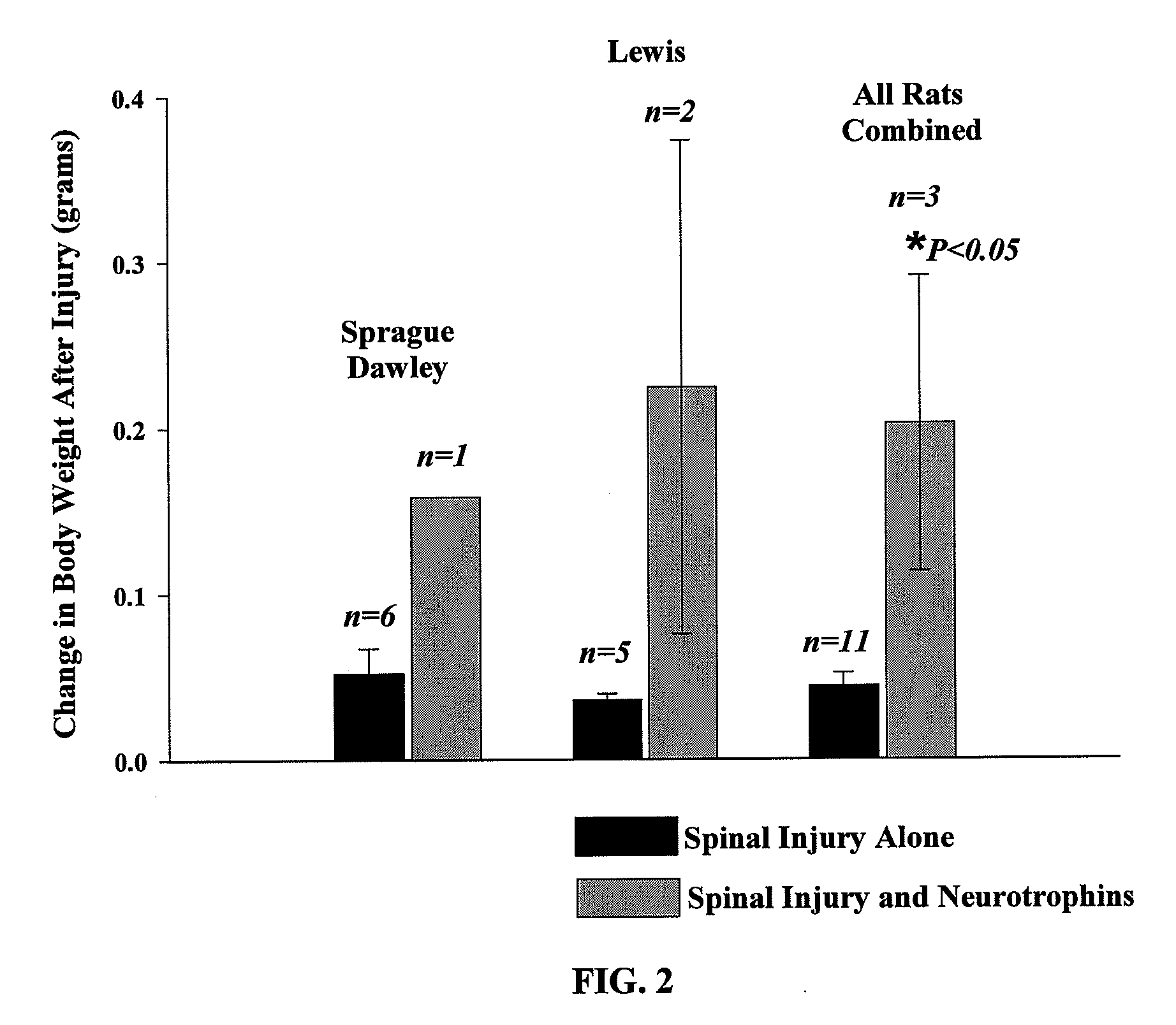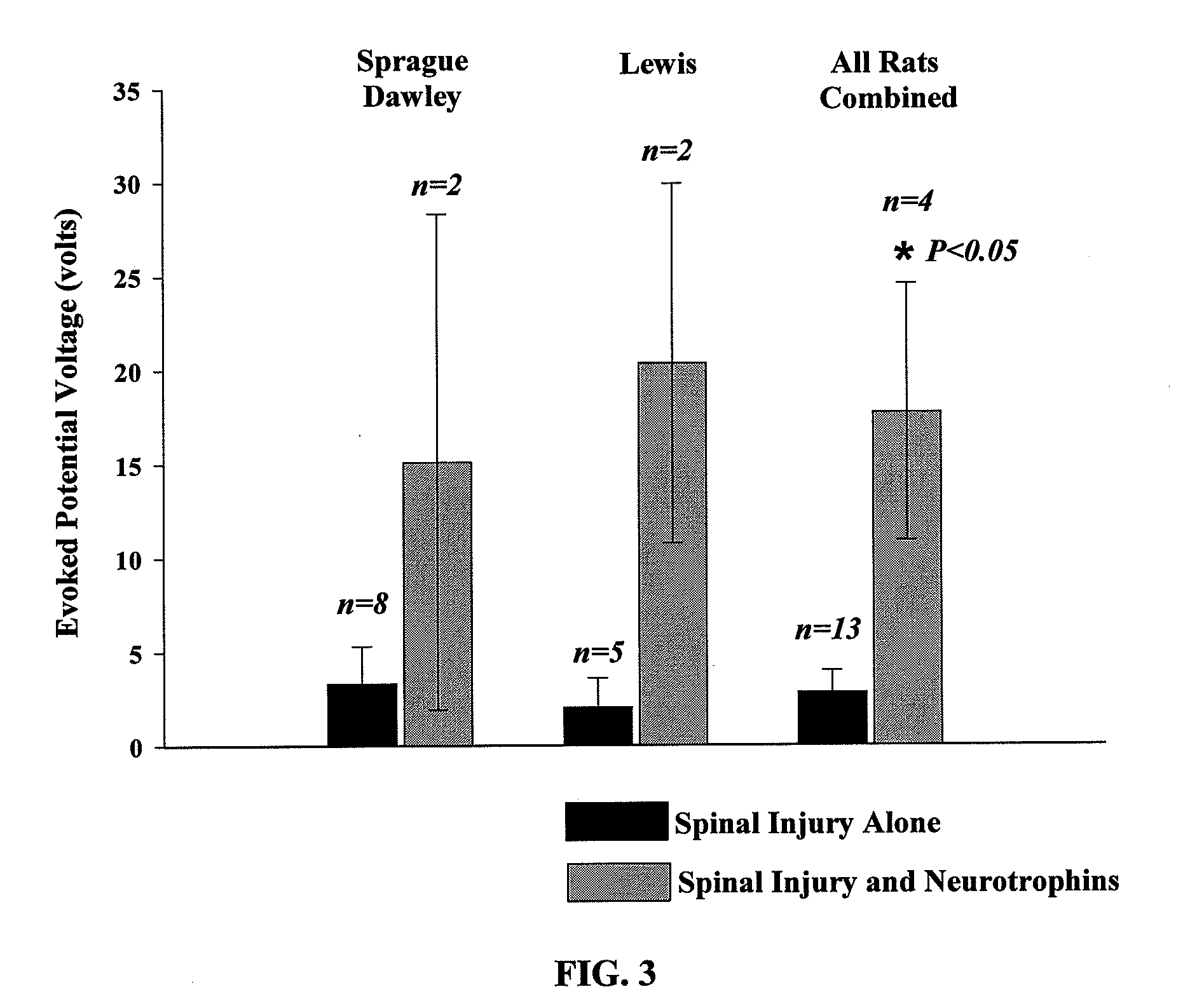Trophic Factor Combinations for Nervous System Treatment
a neurochemical active agent and neurochemical technology, applied in the field of neurochemical active agent combinations, can solve the problems of traumatic injuries, nerve system injuries in numerous ways, and traumatic injuries
- Summary
- Abstract
- Description
- Claims
- Application Information
AI Technical Summary
Benefits of technology
Problems solved by technology
Method used
Image
Examples
example 1
Materials and Methods
[0103]Experiments were performed on 3-5 month old male Sprague-Dawley (SD) and Lewis rats that were housed individually with free access to food and water. Rats were placed into four groups: 1) spinally injured SD rats without a trophic factor combination administered (n=8), 2) spinally injured SD rats with a trophic factor combination (n=2); 3) spinally injured Lewis rats without a trophic factor combination administered (n=5), and 4) spinally injured Lewis rats with a trophic factor combination administered (n=2).
[0104]Spinal cord injury. Rats were anesthetized with medetomidine (75 μg / kg i.m.) and isoflurane in oxygen. After oro-tracheal intubation, anesthesia was maintained with isoflurane in oxygen and rats were mechanically ventilated. A laminectomy was made at the second cervical vertebral level to allow the second cervical spinal segment and the cranial segment of the third cervical spinal segment to be exposed. A 1-mm-long left-sided hemisection was mad...
example 2
[0115]This study was performed to determine whether application of a trophic factor combination can improve motor function after spinal cord injury (SCI). In this study, the trophic factor combination of Example 1 was applied and included insulin-like growth factor (IGF-1), brain-derived neurotrophic factor (BDNF), bactenesin (BNP-1), and substance P. The trophic factor combination was applied to test whether this combination would augment spontaneous respiratory motor recovery in a well-defined model of high cervical incomplete spinal cord injury (C2 hemisection). The trophic factor combination was applied to the injured spinal cord at the time of surgical injury. At 2 weeks post-injury, respiratory motor output was recorded bilaterally from phrenic nerves in urethane anesthetized, vagotomized, and mechanically ventilated spinally injured Lewis male rats (SCI-only: n=6; SCI+trophic factor combination; n=6, with some of these rats being the same as the rats in Example 1). Body weigh...
example 3
[0116]Subtractive studies. Experiments can be performed on rats in accordance with the methods described in Example 2 except that fewer than all four components, i.e., insulin-like growth factor (IGF-1), brain-derived neurotrophic factor (BDNF), bactenesin (BNP-1), and substance P, of the trophic factor combination can be used (except for one or more controls using all four components). Different components can also be used. For example, a different growth factor (and / or neurotrophin and / or neuropeptide and / or antimicrobial peptide) can be used than the one listed above. Studies can also be run using only one component, i.e., either IGF-1, BDNF, BNP-1, or substance P or any other trophic factor to determine the effects of the individual components. Studies can also be performed using combinations of two of the components and using combinations of three of the components to determine whether all four components are needed to achieve the desired results.
PUM
| Property | Measurement | Unit |
|---|---|---|
| neuronal plasticity | aaaaa | aaaaa |
Abstract
Description
Claims
Application Information
 Login to View More
Login to View More - R&D
- Intellectual Property
- Life Sciences
- Materials
- Tech Scout
- Unparalleled Data Quality
- Higher Quality Content
- 60% Fewer Hallucinations
Browse by: Latest US Patents, China's latest patents, Technical Efficacy Thesaurus, Application Domain, Technology Topic, Popular Technical Reports.
© 2025 PatSnap. All rights reserved.Legal|Privacy policy|Modern Slavery Act Transparency Statement|Sitemap|About US| Contact US: help@patsnap.com



